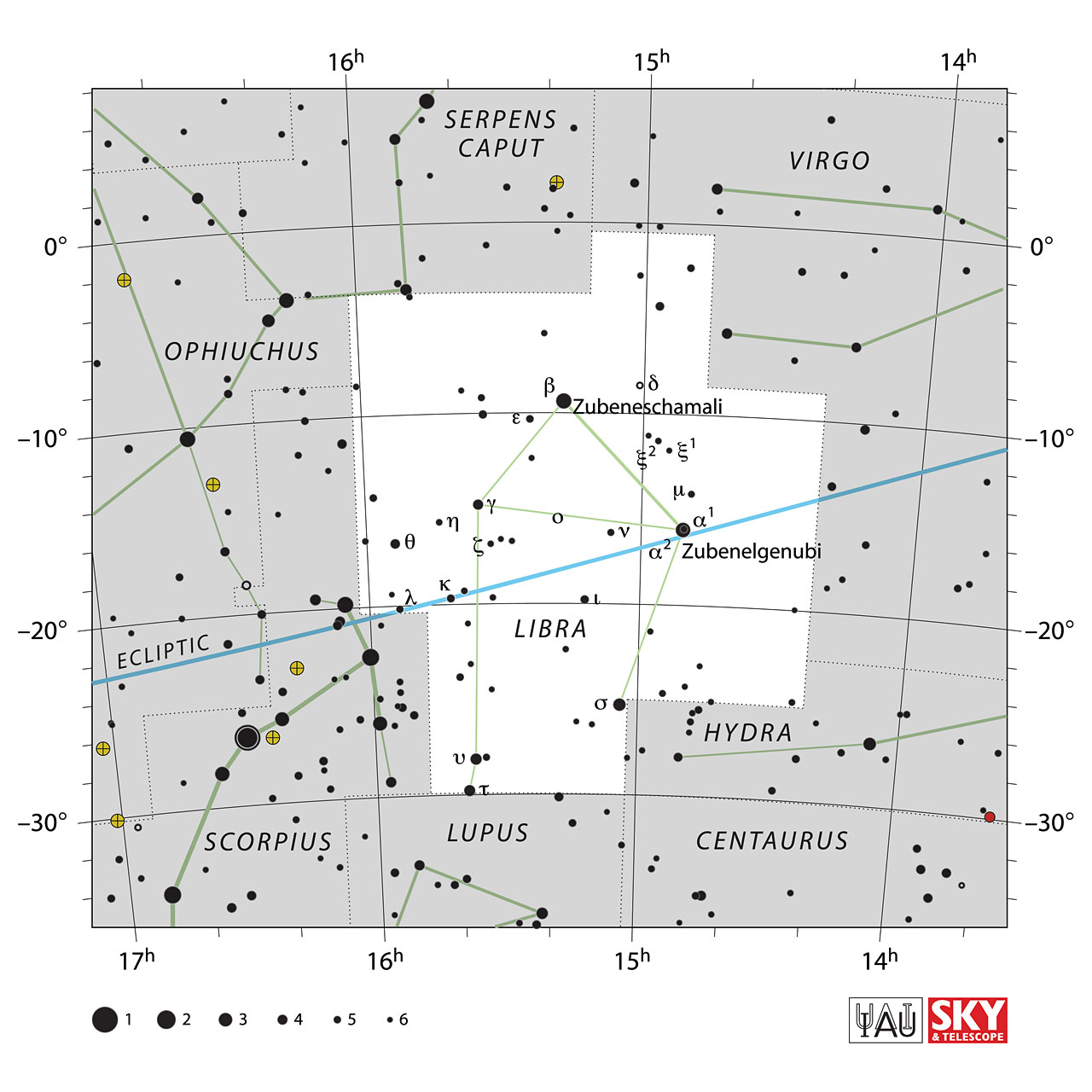Libra


Libra is an equatorial constellation which culminates at midnight in May.
The name ‘Libra’ is Latin for ‘scales’, making it the only one of the zodiacal constellations to be named after an inanimate object.
It is a relatively late addition to the zodiac: until Roman times, this part of the ecliptic was assigned to Scorpius, the scorpion. This is still reflected in the names of its two brightest stars, Zubenelgenubi and Zubeneschamali, Arabic for the southern claw and the northern claw respectively.
In more recent times, Libra has usually been more closely associated with its western neighbor Virgo, the virgin, who is often depicted holding the scales of justice.
Each year, the Sun lies in Libra for the first three weeks of November.
Libra, the scales, represents the equality of the days and nights at the equinoxes. It has more recently come to be associated with Virgo, the goddess of justice, who used these scales as a symbol of her office. Libra is represented in the heavens next to the hand of Virgo.
Libra was known in Babylonian astronomy as MUL Zibanu (the “scales” or “balance”), or alternatively as the Claws of the Scorpion. The scales were held sacred to the sun god Shamash, who was also the patron of truth and justice.
In Arabic zubānā means “scorpion’s claws”, and likely similarly in other Semitic languages: this resemblance of words may be why the Scorpion’s claws became the Scales.
It has also been suggested that the scales are an allusion to the fact that when the sun entered this part of the ecliptic at the autumnal equinox, the days and nights are equal.
In ancient Egypt the three brightest stars of Libra (α, β, and σ Librae) formed a constellation that was viewed as a boat.
Situated away from the plane of the Milky Way, Libra is home to only one bright deep sky object: the ninth-magnitude globular cluster NGC 5897.
Libra contains:
-
Stars
- Zubeneschamali (mag 2.6)
- Zubenelgenubi (mag 2.7)
- σ-Lib (mag 3.3)
- υ-Lib (mag 3.6)
- τ-Lib (mag 3.7)
- γ-Lib (mag 3.9)
- θ-Lib (mag 4.1)
- 16-Lib (mag 4.5)
- ι-Lib (mag 4.6)
- 37-Lib (mag 4.6)
- κ-Lib (mag 4.8)
- ε-Lib (mag 4.9)
- FX Lib (mag 4.9)
- 11-Lib (mag 4.9)
- 42-Lib (mag 5.0)
- δ-Lib (mag 5.0)
- λ-Lib (mag 5.0)
- HD 138764 (mag 5.1)
- 36-Lib (mag 5.1)
- α¹-Lib (mag 5.2)
- ν-Lib (mag 5.2)
- 12-Lib (mag 5.3)
- HD 126218 (mag 5.3)
- 41-Lib (mag 5.4)
- η-Lib (mag 5.4)
-
Open Clusters
- None
-
Globular Clusters
- NGC 5897 (mag 8.4)
- None
-
Galaxy
- NGC 5812 (mag 11.2)
- NGC 5903 (mag 11.5)
- NGC 5878 (mag 11.5)
- NGC 5898 (mag 11.5)
- NGC 5885 (mag 11.7)
- NGC 5792 (mag 11.8)
- NGC 5892 (mag 12.0)
- NGC 5605 (mag 12.0)
- NGC 5595 (mag 12.0)
- NGC 5861 (mag 12.6)
- NGC 5729 (mag 12.8)
- IC 4538 (mag 12.8)
- NGC 5791 (mag 12.9)
- NGC 5796 (mag 13.0)
- NGC 5756 (mag 13.0)
- NGC 5716 (mag 13.0)
- NGC 5915 (mag 13.1)
- IC 1055 (mag 13.3)
- NGC 5793 (mag 13.3)
- NGC 5728 (mag 13.4)
- IC 1077 (mag 13.5)
- NGC 5761 (mag 13.6)
- NGC 5995 (mag 13.7)
- NGC 5917 (mag 13.7)
- IC 4536 (mag 13.7)
View Libra in 3D 
Source: Wikipedia, in-the-sky.org
Image Courtesy: Sky&Telescope & IAU, Illustration Images linked from Urania's Mirror on Wikmedia Commons by Sidney Hall
Image Courtesy: Sky&Telescope & IAU, Illustration Images linked from Urania's Mirror on Wikmedia Commons by Sidney Hall
